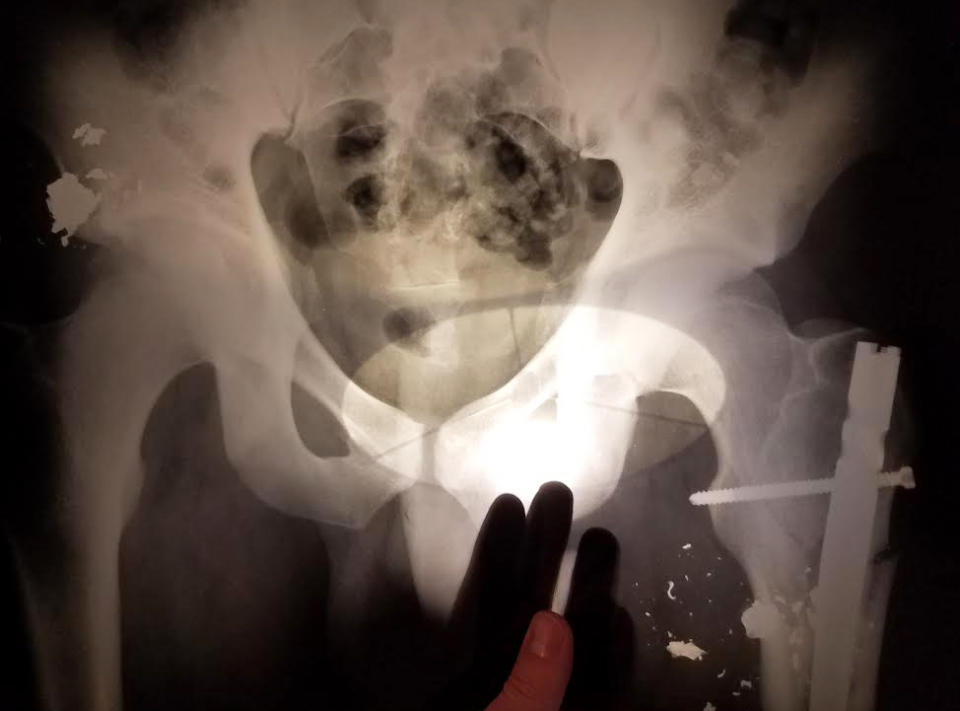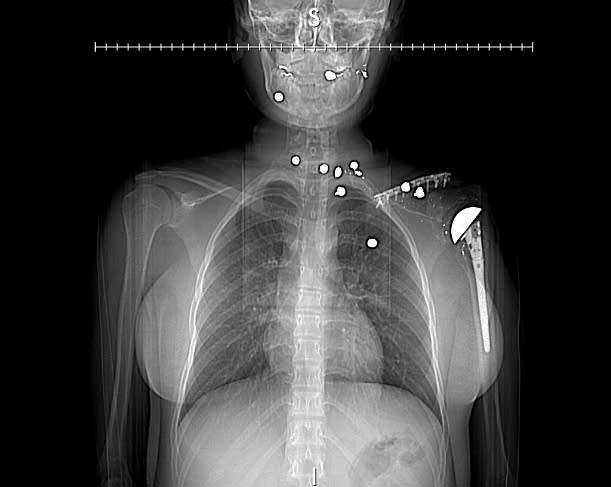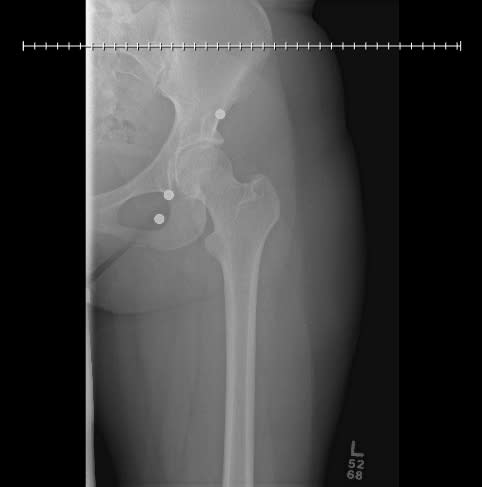They Survived Mass Shootings. Years Later, The Bullets Are Still Trying to Kill Them
Colin Goddard lay in a pool of his own blood, hoping his racing heart would not tip off the approaching gunman that he was still alive. The shooter hovered over Goddard, paused and fired two more bullets into him anyway.
Goddard survived the April 16, 2007 massacre at Virginia Tech, which killed 32 people and was the worst school shooting in U.S. history. Twelve years later, he tries not to dwell on the day, but he has dozens of constant reminders: bullet fragments lodged in his body, leaching toxins into his blood.
Like hundreds and possibly thousands of shooting survivors across the country, Goddard, a 33-year-old father of two, is suffering a lesser-known and often unrecognized side effect of gun violence: lead poisoning. When he was shot in his French class that spring day, one bullet pierced his right shoulder cleanly, but three others shattered when they hit his hips and left knee. Because the fragments did not pose life-threatening risks, trauma surgeons left them in his body—a common and widely accepted practice in emergency rooms throughout the United States. Now, with his blood lead levels seven times higher than what is considered safe, Goddard faces long-term health risks, including neurological problems, kidney dysfunction and reproductive issues.
The metal’s toxicity is well-documented, but only wildlife have so far benefitted from efforts to outlaw its use in bullets, and even those results have been limited. California on July 1 will become the first state to ban lead hunting bullets, the culmination of a yearslong battle that pitted environmentalists against the National Rifle Association and other gun-rights groups.
“I was told, ‘You’re going to be fine in the long-term,’ and that’s not right,” Goddard says. “It throws you back when you realize you’re not out of the woods yet, and this terrible day is not entirely behind you.”
—
With roughly 80,500 nonfatal gunshot injuries annually, a vast number of Americans every year experience a version of Goddard’s worst day, according to the U.S. Centers for Disease Control and Prevention (CDC). Tens of thousands more don’t live through their ordeal. In 2017, the most recent year with available data on mortality, more people in the U.S.—nearly 40,000—died from firearm injuries than in any other year since at least 1968, when the government first started keeping track electronically. It was the third consecutive year that the U.S. saw a rise in the rate of gun deaths. “Doctors think we solved the lead problem because we took lead out of paint and we took lead out of gas,” Goddard says. “But we still have these very acute, very severe problems within a big population of the country—a population that’s already been victimized in a significant way.”

In 2017, when the CDC released its first report linking lead toxicity to bullet fragments, the health agency said at least 457 adult shooting survivors tested positive for elevated blood lead levels from retained bullet fragments between 2003 and 2012. As its main source, the CDC pulled data from 41 states participating in the Adult Blood Lead Epidemiology and Surveillance (ABLES) program, which requires labs and health care providers to report blood lead level test results to their state health departments. The program requires states to specify the sources of lead exposure—paint versus bullets, for example—but many states did not comply. That made it impossible for researchers to draw conclusions on the full magnitude of the national issue, and the true tally was likely far higher than 457, says CDC epidemiologist Debora Weiss, the report’s lead author.
It’s even harder to collect such data today. Since it released the report, the CDC has stopped studying the issue—citing a drop in the number of states willing to submit sufficient information—and the federal government eliminated the program’s funding in 2013. When it restored funding in 2015, only 26 states were part of the program, according to the CDC. “The biggest unanswered question,” Weiss says, “is whether the number of cases is increasing, becoming a trend.”
There is no evidence the exposure has slowed. In at least 12 ABLES states that do track different lead exposure sources, roughly 300 people tested positive for elevated lead levels from retained bullet fragments between 2012 and 2018, according to data obtained by TIME. During that time period, more than 200 people in California tested positive for elevated blood lead levels from retained bullet fragments, as did 28 people in Missouri, according to the states’ health departments. In Michigan, where the Flint water crisis created a heightened awareness of the dangers of lead, nearly 60 shooting victims tested positive for lead toxicity from bullets between 2012 and 2016, the most recent year with data, health officials said.
“There’s clearly sufficient research that substantiates cause for concern. There’s no doubt about that,” says Donald Smith, a professor of toxicology at the University of California, Santa Cruz, whose research team helped the state ban the use of lead ammunition by hunters. While studying the effects of lead toxicity in California condors—one of the world’s largest birds threatened with extinction—the researchers found the creatures were dying in droves or being severely sickened from lead poison, primarily by eating the carcasses of animals that had been shot with lead ammunition, but also by being shot with lead bullets themselves. “Take it from the condors,” Smith says. “Embedded lead from ammunition poses significant toxic concerns.”
Decades of research into the effects of lead-tainted paint, fuel and drinking water have shown its devastating impact on humans and forced policy changes. In 1978, the U.S. banned consumer uses of paint containing lead. In 1996, the federal government went a step further, prohibiting the sale of leaded fuel. The public health crisis in Flint, Mich. put the national spotlight back on lead in 2014 when the city’s water supply became contaminated with it after officials switched water sources.
Because lead is common and inexpensive, it has long been the metal of choice for product manufacturers in many industries, including ammunition, says Michael Helms, a firearms historian in Baton Rouge, La. The material is also heavy and dense, Helms says, which helps bullets maintain consistent trajectories as opposed to those made with copper. This ensures maximum damage when a target is hit. Of the 9 billion ammunition rounds produced in the U.S. or imported into the country each year, 95% are made with lead components, according to the National Shooting Sports Foundation, a gun trade group. “If you have the misfortune of being shot,” says retired U.S. Environmental Protection Agency toxicologist Mark Maddaloni, “the bullet is probably going to be made of lead.” Yet when it comes to how much we know about the internal impact of lead from retained bullets, much is shrouded in mystery.
That’s partially because it’s difficult to detect. Lead poisoning’s symptoms—fatigue, headaches, abdominal pain, nausea—are often mistaken for common illnesses like the cold or a stomach bug. “It’s really difficult sometimes for physicians who are treating these patients years after they’ve been shot to diagnose and figure out exactly what the problem is,” says Dr. Jennifer Cone, a trauma surgeon who frequently operates on gunshot victims in Chicago. “If somebody has these symptoms, it’s much more common for them to have menstrual cramps or a virus or gastroenteritis.”
—
In February 2017, Goddard, the Virginia Tech survivor, was a new father and a grad student at the University of Maryland, so he dismissed his fatigue as a natural byproduct of his busy life. He’d never considered he might have lead poisoning, but after his mother read the CDC’s report, she emailed him to suggest he get his blood tested. “I think it’s a good precaution,” she wrote, “but I wouldn’t worry at this point.”

“Gulp,” he replied. “Will call the Health Center to determine options.”
Ten days later, Goddard’s blood test came back. His blood lead level was 37 micrograms per deciliter. On average, a healthy adult has a blood lead level of 2 micrograms per deciliter, according to Maddaloni, the retired EPA toxicologist. While the World Health Organization says no level of lead exposure is considered safe, the CDC recommends taking action when blood lead levels are above 5 micrograms per deciliter.
Goddard underwent surgery later that year to remove some of the bullet fragments in his hip, which only slightly decreased his blood lead levels. While toxicologists insist the remaining 50 or more pieces need to come out, doctors say it’s too dangerous to remove them. Now, the business-development director in Bethesda, Md., has to swallow 31 pills a day as part of his chelation treatment, a chemical process used to rid the body of excess or toxic metals. The treatment only works as long as he takes the pills. If he stops, the lead levels rise again and he’s back to where he started.
“It feels like you’re a frog in boiling water. You don’t know these small changes in you until it’s too late,” says Goddard.
—
Unless there’s an immediate danger—if the bullets are near a major organ like the heart, or a large blood vessel—or unless the pieces have surfaced near the skin and are easy to remove, surgeons leave them in. Of the roughly 1,000 gunshot victims treated every year at the University of Chicago Medicine alone, up to 75% walk out with bullets still in their bodies, according to Cone, the trauma surgeon. Every day, at least one patient is patched up with a retained bullet, she says. And at SSM Health Saint Louis University Hospital in St. Louis—which, according to FBI statistics, has the highest murder rate among major cities in the nation—up to 75% of the roughly 450 annual gunshot victims leave with retained bullet fragments, says trauma surgeon Dr. Carl Freeman. “Oftentimes going in to get the bullet causes more harm than good,” says Cone. “We cut through healthy tissue, blood vessel and nerves, and it can cause a lot of scarring or other issues down the road.”

Often, the body will naturally form a protective barrier of scar tissue around a bullet or fragment, resulting in little to no damage, Cone says. “In the past, it’s been thought that these bullets are completely benign,” she adds. But sometimes, as years pass, the fragments dissolve and start making their way through the bloodstream, causing lead poisoning.
—
Even the best surgeons in the world couldn’t remove the shrapnel embedded in Morgan Workman’s left leg after she was blasted with an assault-style rifle during Sunday services at the First Baptist Church in Sutherland Springs, Texas. The fragments, small as sawdust, look like purple freckles on her calf—a permanent mark from the rampage on Nov. 5, 2017 that killed 26 fellow congregants, including six close friends. “To remove it all,” Workman says of the shrapnel, “they basically would have had to tear my leg apart.”
As a gunman wearing all-black tactical gear and a ballistic vest opened fire in the church she’d attended most of her life, Workman dropped to the floor and hid behind equipment in the sound booth in the back of the sanctuary, where she works as a technician. “My brain was like, you’re never going to eat a chocolate chip cookie again,” she recalls. “That’s the first thing that came across my head.” But survival mode kicked in and she started counting the number of reloads and rounds fired while ducking her head side-to-side to avoid the shooter. And then she was hit.
Compared to others, her injury was minor, Workman says, and she was off crutches and back to work within weeks, but she suddenly started losing control of both of her feet. “I fell up the stairs at my house about four or five times in two weeks,” says the 21-year-old from La Vernia, Texas. “I knew something was wrong.” Her condition baffled her and her doctors. It wasn’t until almost a year later that Workman learned she had a blood lead level of 10 micrograms per deciliter, which was triggering foot drop, which causes her to lose control of the muscles that let her raise the front parts of her feet. “I’m not a person who cries a whole lot, but when I actually found out what was causing the problem, I just broke down immediately,” she says.
Workman, who later married another survivor of the church shooting, now has to wear braces on both feet, but she’s gotten her blood lead levels down to 2 micrograms per deciliter through chelation. In the immediate aftermath of the tragedy, Workman says no medical professionals had advised her to get tested for lead toxicity. Now, she and her family want to save other shooting survivors from suffering the months of uncertainty that plagued her before she was correctly diagnosed. So in December 2018, Workman’s mother-in-law, Julie Workman, a nurse who also survived the massacre, traveled some 200 miles to Santa Fe, Texas, to warn the victims of the latest mass shooting about the dangers of lead in bullets.
She passed the message on to Sonia Lopez, whose daughter, Sarah Salazar, survived a mass shooting at Santa Fe High School that killed 10 people on May 18, 2018. Sarah was shot three times, leaving her with approximately 20 shotgun pellets embedded in multiple parts of her body, including her left lung and around her spinal cord. One of the major veins on the left side of Sarah’s neck was severed, her jaw had to be wired shut, and she lost a significant amount of flesh on the left side of her left arm.

The 17-year-old honor roll student also complained of headaches, fatigue and light-headedness after the shooting, but it never occurred to Lopez, 53, that her daughter could have lead poisoning.
Heeding Workman’s warning, Lopez demanded doctors test Sarah’s blood. They found she had a blood lead level of 21 micrograms per deciliter. On April 12, Sarah had six of the roughly 20 pellets surgically removed and was put on the same chelation treatment as Goddard and Morgan Workman. A month later, her blood lead level was still at 15, meaning doctors will have to consider more invasive surgery in the chest and lung. “She just feels sick all the time,” Lopez says of her once-active daughter.
—
The last time the government regulated lead ammunition on a national level was in 1991. After researchers found some 2 million ducks were dying each year from ingesting spent lead shot left by hunters, the U.S. Fish and Wildlife Service outlawed their use in hunting migratory waterfowl. For the last decade, conservationists have been pushing the U.S. to expand restrictions to hunting of other species, because they say lead in hunting ammunition still poisons and kills between 10 million and 20 million animals every year. But wildlife advocates have faced fierce opposition from gun rights advocates.
In 2017, when President Barack Obama’s administration announced a ban on lead ammunition on federal wildlife refuges on the last full day of his presidency, the NRA criticized the move as an “attack on our hunting heritage.” The ban was reversed as soon as the new U.S. Interior Secretary under President Donald Trump took over. “It is a losing battle in the Trump administration,” says Jonathan Evans, an environmental health legal director at the Center for Biological Diversity, a conservation group that has unsuccessfully challenged the NRA in court over banning lead ammo.
Conservationists have since shifted their focus toward making progress at the state level. Besides California, more than 30 other states have imposed less-stringent rules on lead ammunition used by hunters, according to the Humane Society. “We know it can be done,” Evans says.
For animals, maybe, but not necessarily for humans. Doctors are growing more aware of the risks human shooting survivors face from lead, but many feel their hands are tied by a lack of research into treatment alternatives for gunshot victims whose bodies are saturated with bullet fragments. “We’re not doing enough for them,” says Dr. Ikenna Okereke, the University of Texas Medical Branch’s chief of thoracic surgery, who is treating Sarah Salazar. “It’s a huge problem, and I’m seeing it more and more. And if I’m just one physician seeing it more and more, it’s just the tip of the iceberg.”

